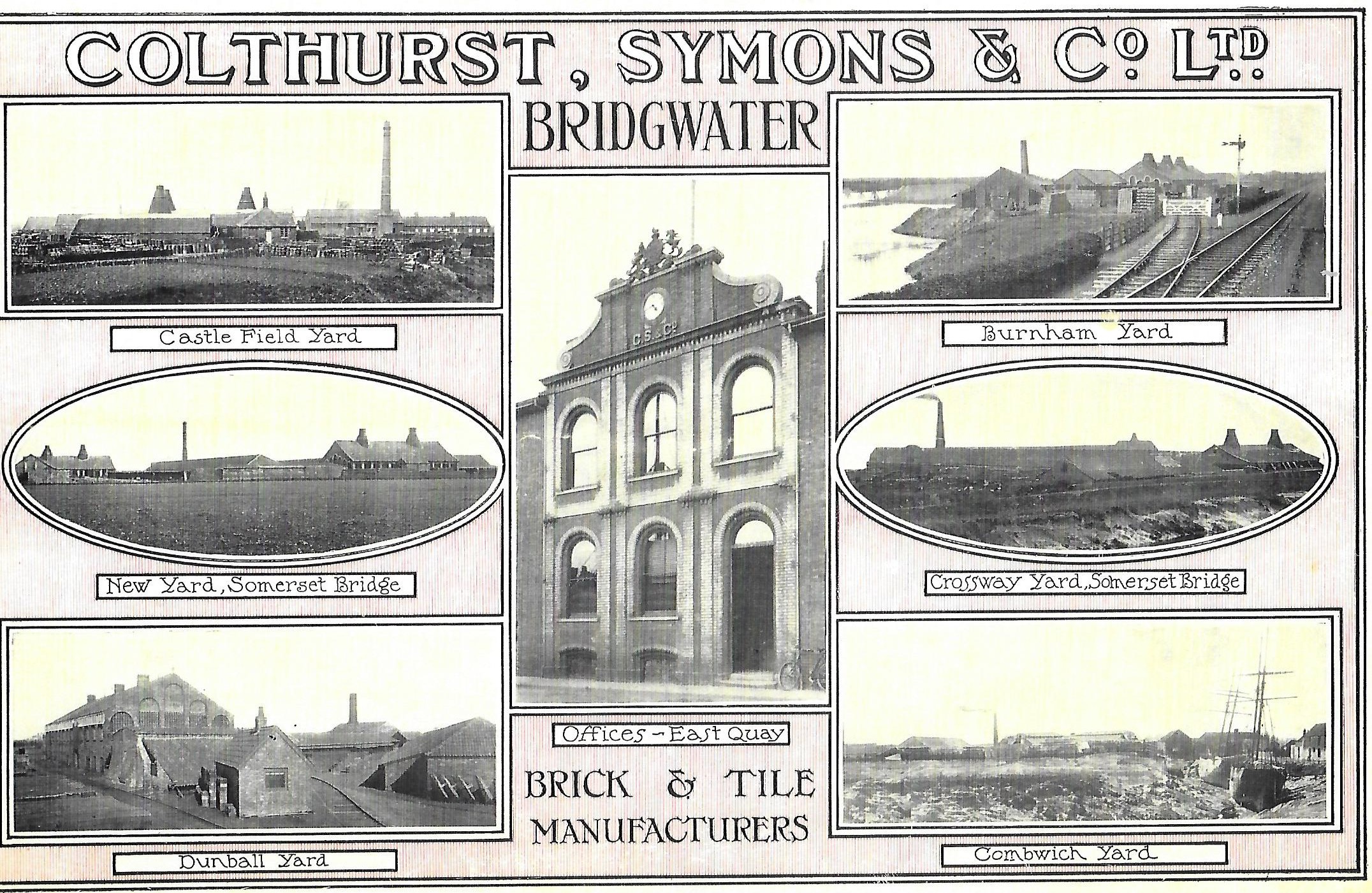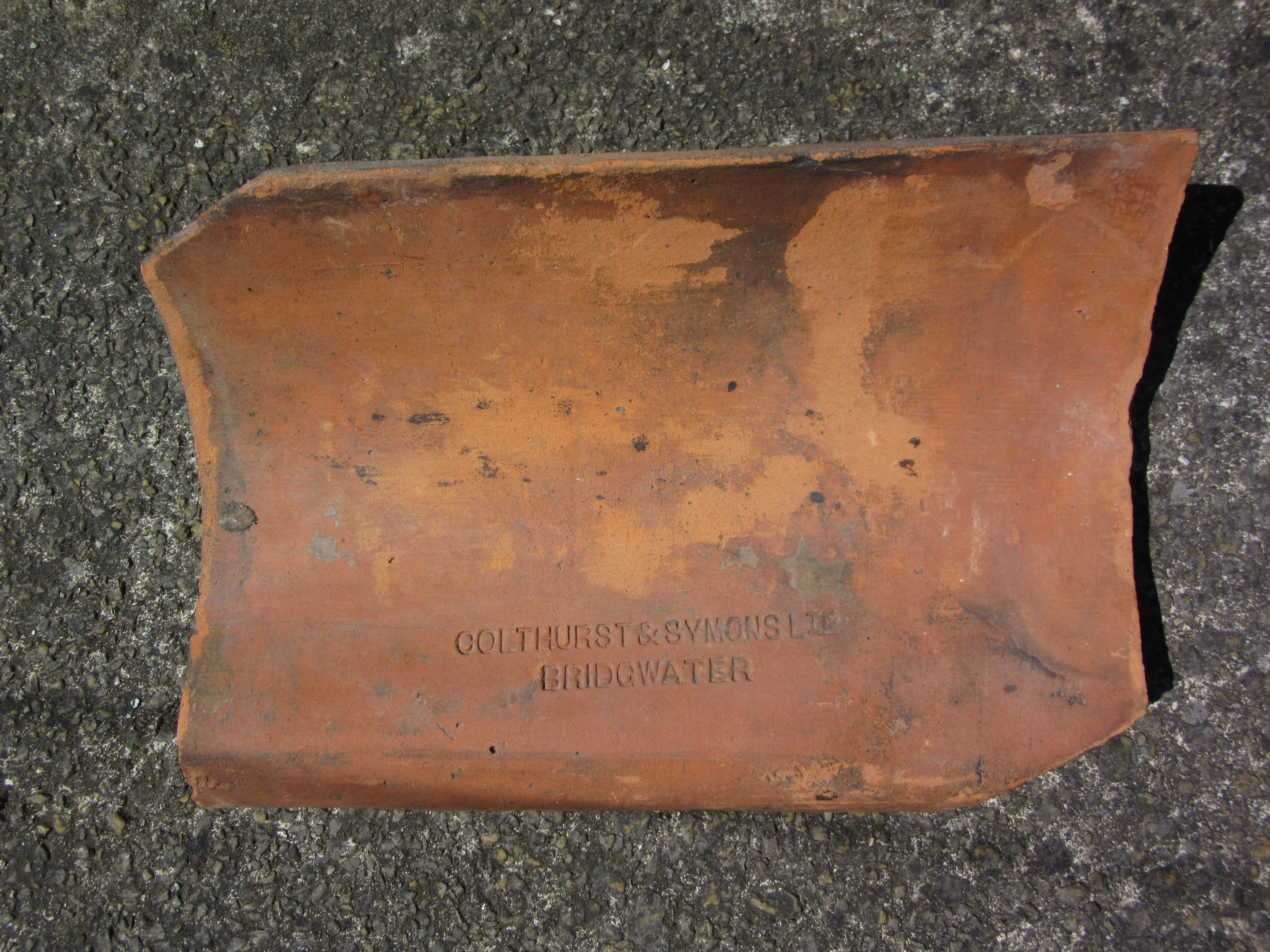Today’s post continues the story of the Symons family of Somerset brickmakers. Last time we found out how everything began, with William Symons of Stogursey who joined Thomas Colthurst to form Colthurst, Symons & Co. in 1857. We also discovered how the Bridgwater area was perfect for brick and tile making due to an abundance of raw materials. This instalment follows William’s eldest son (also named William) on his journey.
William Symons junior
From what I have discovered about William junior, he seems to have been quite a transient person. Unlike other ancestors I have found who settled and stayed in the same area for a great deal of their lives, William moved around a lot. He began life in Bridgwater and was baptised there on the 07 March 1827 at St. Mary’s Church.[1] As a 14 year old, he lived with his parents William and Ann and siblings James, John, Clifford and Ellen in Hamp, near Bridgwater.[2] But three years later (1844) is when things get a bit more interesting. 1844 is the birth year of William junior’s eldest son, confusingly also called William! The interesting thing is that William did not marry wife Sophia until 1849.[3] If you do the maths on this, then it shows that William was 17 in 1844, which would have been below the age he was allowed to marry without parental consent. It seems he had an illegitimate child with Sophia and she baptised the child under her name of ‘Duddridge.’[4] This William’s birth certificate is however, filed under Symons. Sophia Dudridge is named as the mother, but William Symons is named as the father. As Sophia is only named by her maiden name this indicates that they were likely unmarried at the time.[5]
 |
| Family Tree for William Symons junior (1827-1911). © Shersca Genealogy, 2020. |
The legislation requiring both parents of an illegitimate child to be present at the registration didn’t come in until 1874, so William may or may not have given his consent to be named. Perhaps though, this did show the couple’s intentions as they did marry later. This William seemed to live with his grandparents (Sophia’s parents) and not his parents.[6] [7] This illegitimacy would have been fairly scandalous at the time- who knows, perhaps it had a bearing on William senior's involvement (or lack of) in his father’s brickmaking business. Maybe he had another career in mind, as on both his first son’s birth certificate and his marriage certificate, he says that he is a baker.
William's next move
Who knows, perhaps the stigma was so great that this was the reason that William had moved to Neath, near Swansea in Wales by 1851. His wife Sophia and their next son James were with him and William was recorded as being a brickmaker. There are of course, other reasons why William could have gone to Wales. He may have tried to find work- there were various brickworks in Neath and the surrounding areas.[8] It is unclear how he became a brickmaker (maybe baking wasn’t working out for him), but perhaps unsurprising because of the growing popularity of the trade in the area where he grew up.
Perhaps you might think that William settled down in Wales after joining a Welsh brickmaker? No he did not. His son John was born back in Bridgwater (abt. 1852) and his daughters Mary Ann and Clara were born in North Petherton in abt. 1853 and 1855 respectively. Then yet again, the family were off in 1861 and were living in Eaton Hastings in Berkshire.[9] William’s occupation is pretty vague and only says ‘contractor,’ but by this time, his father was involved with Colthurst, Symons & Co. Perhaps William was sent to investigate business opportunities in the area? According to the Eaton Hastings entry in the Victoria County History, there are disused clay-pits in the vicinity and clay is what you need to make bricks.[10]
The brickyard manager
 |
| Part of promotional material for Colthurst, Symons & Co, showing their brickyards. Passed down through my family. |
The next chapter in William’s history is the one which has interested me most because it sees the entry of a particular house. This house is called Midway House and it is located in Burnham on Sea, Somerset. Midway House becomes an important part of the story of my ancestors, but only makes a fleeting appearance in William’s story. He, his wife Sophia and children John, Mary Ann and Clara lived there in 1871, but had left by 1875.[11] This time around, William is the manager of a brickyard and this speaks to the purpose of the house he lived in. The residents of Midway House are inextricably linked with the purpose of the land around the house. Each head of household that I have found on the UK census records was recorded as a brickyard manager, most likely for the adjoining brickworks owned by Colthurst, Symons & Co.[12] The next occupant appeared in 1875,[13] but more about him next time.
Meanwhile, William had moved again, but into Bridgwater this time. Perhaps he moved closer to the main hub of the family business. Sadly, his address can be found on his wife Sophia’s death certificate. She died on the 28 June 1876, at 48 Wellington Road, Bridgwater.[14] I can’t imagine how hard that must have been for William and his family, especially as Sophia was only 49. It seems that she died from liver and kidney problems and excess fluid in the kidneys (dropsy). At this time William was still a tile manufacturer, but perhaps Sophia’s death prompted the complete change in occupation and yet another move.
The Gloucester years
William’s second marriage took place on the 18 July 1878 to Charlotte Ford (neé Smith) at the Register Office in the Aston District of Warwickshire.[15] Both had been married before and seemingly lost spouses to premature deaths. But yet again, does William settle in Warwickshire? No, he moves with Charlotte and the children from her previous marriage to Gloucestershire. Even more surprising, is the fact that he becomes a publican! He was a merchant and Inn Keeper of the Goat Inn on Llanthony Road, South Hamlet, Gloucester.[16] There may have been more to this move that it being purely random. In the previous post, remember that William’s younger brother John was living in South Hamlet in 1861.[17] But even this change of William’s doesn’t seem to last long. From 1891 until his death, William seems to be moving around Gloucester and ‘living on his own means’ with no discernible occupation. 1891 sees him living at 17 Weston Road,[18] 1901 at 2 Tudor Street (but as a boarder not a head of household)[19] and 1911 at 104 Linden Road with daughters Mary Ann (Marian) and Clara.[20]
The address at Weston Road was unfortunately where William’s second wife, Charlotte died on the 20 July 1895 from heart disease and associated syncope.[21] She was only 67. William himself died on the 29 August 1911 at 104 Linden Road, aged 84. It is perhaps some comfort to see that his daughter Clara was present when he died.[22]
Conclusions
William is a very obvious case to remind us that our ancestors could have moved around much more than we think. There are ten years between each census entry after all. A lot can happen in that time, especially as movement became easier in the 19th century. William’s story does give me the impression of someone who had not quite found where they belonged in life. With several changes of occupation and many changes of location over the years, perhaps William was struggling to find his place. Although we may never know for sure.
Stay tuned for part three of the Symons story, with the addition of the Peirces and a certain house in Burnham on Sea!
Copyright © 2020 Shersca Genealogy
[1] Baptisms (PR) England. Bridgwater (St. Mary), Somerset. 07 March 1827. SYMONS, William. Collection: Somerset, England, Church of England Baptisms, Marriages and Burials, 1531-1812. www.ancestry.co.uk : accessed 07 July 2020.
[2] Census. 1841. England. Hamp, Bridgwater, Somerset. PN: HO107/971. FL 48. BN 2. ED 4. p. 39. http://www.ancestry.co.uk : accessed 06 July 2020.
[3] Marriages (CR) England. Register Office, Axbridge Union, Somerset. 04 April 1849. SYMONS, William and DUDRIDGE, Sophia. Entry no. 158.
[4] Baptisms (PR) England. Bridgwater (St. Mary), Somerset. 22 September 1844. DUDDRIDGE, William. Collection: Somerset, England, Church of England Baptisms, 1813-1914. www.ancestry.co.uk : accessed 07 July 2020.
[5] Births (CR) England. Hamp, Bridgwater, Somerset. 31 July 1844. SYMONS, William. Entry no. 445.
[6] Census. 1841. England. Hamp, Bridgwater, Somerset. PN: HO107/1925. FL 118. ED 1d. p. 51. http://www.ancestry.co.uk : accessed 07 July 2020.
[7] Census. 1861. England. Bridgwater, Somerset. PN: RG9/1624. FL 18. SN 156. ED 1. p. 30. http://www.ancestry.co.uk : accessed 07 July 2020.
[8] Jenkins, Phil. The Brickworks of West Glamorgan: Neath and the Nedd Valley. http://www.industrialgwent.co.uk/g41-westglam/index.htm#neath : accessed 07 July 2020.
[9] Census. 1861. England. Bridgwater, Somerset. PN: RG9/728. FL 86. SN 22. ED 5c. p. 17. http://www.ancestry.co.uk : accessed 07 July 2020.
[10] [Author unknown] (1924) 'Eaton Hastings.' In: Page, William, and Ditchfield, P. H. eds. A History of the County of Berkshire: Volume 4. London: Victoria County History. pp. 528-531. https://www.british-history.ac.uk/vch/berks/vol4/pp528-531 : accessed 07 July 2020.
[11] Census. 1871. England. Burnham, Somerset. PN: RG10/2457. FL 27. SN 58. ED 9. p. 11. http://www.ancestry.co.uk : accessed 23 January 2018.
[12] Murless, Brian J. (2000) Somerset Brick & Tile Manufacturers: A Brief History & Gazetteer. [Place unknown]: Somerset Industrial Archaeological Society. p. 12.
[13] Directories. England. (1875) The Post Office Directory of Somersetshire. London: Kelly And Co. p. 345.
[14] Deaths (CR) England. Bridgwater, Somerset. 20 June 1876. SYMONS, Sophia. Entry no. 123.
[15] Marriages (CR) England. Register Office, Aston District, Warwickshire. 18 July 1878. SYMONS, William and FORD, Charlotte. Entry no. 63.
[16] Census. 1881. England. South Hamlet, Gloucester, Gloucestershre. PN: RG11/2536. FL 41. ED 9. p. 24. http://www.ancestry.co.uk : accessed 07 July 2020.
[17] Census. 1861. England. South Hamlet, Gloucester, Gloucestershire. PN: RG9/1767. FL 109. SN 97. ED 7. p. 19. http://www.ancestry.co.uk : accessed 09 July 2020.
[18] Census. 1891. England. South Hamlet, Gloucester, Gloucestershire. PN: RG12/2016. FL 4. ED 11. p. 2. http://www.ancestry.co.uk : accessed 07 July 2020.
[19] Census. 1901. England. South Hamlet, Gloucester, Gloucestershire. PN: RG13/2431. FL 195. SN 141. ED 33. p. 23. http://www.ancestry.co.uk : accessed 07 July 2020.
[20] Census. 1911. England. Gloucester Southern, Gloucester, Gloucestershire, 325. PN: RG14/15304. ED 10. SN 169. http://www.ancestry.co.uk : accessed 07 July 2020.
[21] Deaths (CR) England. South Hamlet, Gloucester, Gloucestershire. 20 July 1895. SYMONS, Charlotte. Entry no. 334.
[22] Deaths (CR) England. Gloucester Southern, Gloucester, Gloucestershire. 29 August 1911. SYMONS, William. Entry no. 123.
 Family tree for William Symons (1805-1876) © Shersca Genealogy 2020.
Family tree for William Symons (1805-1876) © Shersca Genealogy 2020.